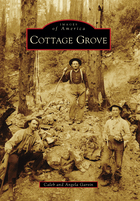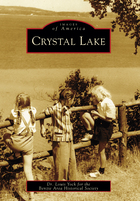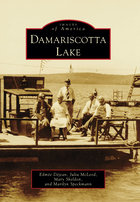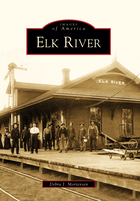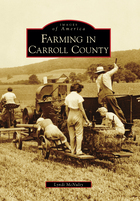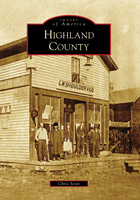Browse Titles - 76 results
2. Civilization at Last
written by Caleb Garvin; in Cottage Grove, Images of America (Charleston, SC: Arcadia Publishing, 2009), 25-40
Cottage Grove is a picturesque little hometown nestled in the Willamette Valley. Pioneers following the Oregon Trail west settled in the area in the early 1800s. The Bohemia Mountains were the first major draw to the area after James "Bohemia" Johnson discovered gold in 1863. A gold rush ensued and caused several...
Sample
written by Caleb Garvin; in Cottage Grove, Images of America (Charleston, SC: Arcadia Publishing, 2009), 25-40
Description
Cottage Grove is a picturesque little hometown nestled in the Willamette Valley. Pioneers following the Oregon Trail west settled in the area in the early 1800s. The Bohemia Mountains were the first major draw to the area after James "Bohemia" Johnson discovered gold in 1863. A gold rush ensued and caused several boom towns to spring up on the route to the mines. After several years, many millions in gold were blasted from the mountains. There is...
Cottage Grove is a picturesque little hometown nestled in the Willamette Valley. Pioneers following the Oregon Trail west settled in the area in the early 1800s. The Bohemia Mountains were the first major draw to the area after James "Bohemia" Johnson discovered gold in 1863. A gold rush ensued and caused several boom towns to spring up on the route to the mines. After several years, many millions in gold were blasted from the mountains. There is an estimated $14 million in gold remaining in the mountain to this day. With new settlers came the first post offices and schools. When the mining started to slow down, the lumber industry was on the upswing. With easy access to the short line and virgin timber on every hill in the valley, timber became the new boom. Mills sprung up almost overnight, and in some cases burned in a single night. At one time, there were 23 mills on Row River alone.
Show more
Show less
Field of Study
American History
Content Type
Book
Author / Creator
Caleb Garvin
Date Published / Released
2009
Publisher
Arcadia Publishing
Series
Images of America
Topic / Theme
Business, Grist mills, Cars, Flours and meal, Oil mines and mining, Buildings, Persons
Copyright Message
Copyright © 2010 by Caleb and Angela Garvin
×
2. Beulah
written by Louis Yock; in Crystal Lake, Images of America (Charleston, SC: Arcadia Publishing, 2009), 33-56
About nine miles long and two miles wide, Crystal Lake has been a recreational center in northwest Michigan for over 100 years. However, resorts and vacations were not the intention of Benzonia’s first settlers, who arrived on Crystal Lake’s eastern shore in 1858 to found a religious colony and a college. In a...
Sample
written by Louis Yock; in Crystal Lake, Images of America (Charleston, SC: Arcadia Publishing, 2009), 33-56
Description
About nine miles long and two miles wide, Crystal Lake has been a recreational center in northwest Michigan for over 100 years. However, resorts and vacations were not the intention of Benzonia’s first settlers, who arrived on Crystal Lake’s eastern shore in 1858 to found a religious colony and a college. In an attempt to increase the area’s economic potential with a navigable channel to Lake Michigan, Crystal Lake was accidentally lowered...
About nine miles long and two miles wide, Crystal Lake has been a recreational center in northwest Michigan for over 100 years. However, resorts and vacations were not the intention of Benzonia’s first settlers, who arrived on Crystal Lake’s eastern shore in 1858 to found a religious colony and a college. In an attempt to increase the area’s economic potential with a navigable channel to Lake Michigan, Crystal Lake was accidentally lowered in 1873. As the waters drained away, an unexpected boon occurred as summer camps, cottages, and resorts sprang up along its shores. The railroads and steamships were quick to follow with eager entrepreneurs, developers, and tourists. Between Frankfort and Point Betsie to the west, and Beulah to the east, an assortment of hideaways and getaways were established to cater to people of differing religions, occupations, and classes.
Show more
Show less
Field of Study
American History
Content Type
Book
Author / Creator
Louis Yock
Date Published / Released
2009
Publisher
Arcadia Publishing
Series
Images of America
Topic / Theme
Sport fishing, Food industry, Independence Day, Tourist attractions, Town life, Vacation spots, Hotels and inns, Leisure time, Towns, Modes of transportation, Nantaughtacund, Tboli
Copyright Message
Copyright © 2009 by Dr. Louis Yock for the Benzie Area Historical Society
×
1. South Arm and Damariscotta Mills
written by Julia Davis McLeod, Edmee Dejean, Mary Sheldon, 1825-1887 and Marilyn Speckmann; in Damariscotta Lake, Images of America (Charleston, SC: Arcadia Publishing, 2011), 9-50
Damariscotta Lake, the link between the towns of Jefferson, Newcastle, and Nobleboro, has always had a unique allure. Each spring, thousands of alewives return from the Atlantic Ocean to struggle up the fish ladder at Damariscotta Mills and reach their traditional spawning grounds. Many early settlers made a livin...
Sample
written by Julia Davis McLeod, Edmee Dejean, Mary Sheldon, 1825-1887 and Marilyn Speckmann; in Damariscotta Lake, Images of America (Charleston, SC: Arcadia Publishing, 2011), 9-50
Description
Damariscotta Lake, the link between the towns of Jefferson, Newcastle, and Nobleboro, has always had a unique allure. Each spring, thousands of alewives return from the Atlantic Ocean to struggle up the fish ladder at Damariscotta Mills and reach their traditional spawning grounds. Many early settlers made a living through shipbuilding, milling, farming, and harvesting ice, wood, and alewives. In the 20th century, the establishment of children's...
Damariscotta Lake, the link between the towns of Jefferson, Newcastle, and Nobleboro, has always had a unique allure. Each spring, thousands of alewives return from the Atlantic Ocean to struggle up the fish ladder at Damariscotta Mills and reach their traditional spawning grounds. Many early settlers made a living through shipbuilding, milling, farming, and harvesting ice, wood, and alewives. In the 20th century, the establishment of children's camps, fishing lodges, cottages, and homes relied on the lake's draw for recreation. The area has been a destination for notables such as Arthur Godfrey and Thomas Watson, writers Henry Beston and Elizabeth Coatsworth, and Pulitzer Prize winners Robert Lowell and Jean Stafford.
Show more
Show less
Field of Study
American History
Content Type
Book
Author / Creator
Julia Davis McLeod, Edmee Dejean, Mary Sheldon, 1825-1887, Marilyn Speckmann
Date Published / Released
2011
Publisher
Arcadia Publishing
Series
Images of America
Topic / Theme
Grist mills, Lakes, Geophysical features
Copyright Message
Copyright © 2011 by Edm�e D�jean, Julia McLeod, Mary Sheldon, and Marilyn Speckmann
×
2. The Gristmill
written by Patrica C. Sympson; in East Rockaway, Images of America (Charleston, SC: Arcadia Publishing, 2009), 13-28
East Rockaway is a village on the south shore of Nassau County, Long Island. In 1689, Joseph Haviland built a gristmill, which became the center of economic, social, and cultural life for the next century and a half, until the arrival of the railroad changed the focus of East Rockaway. Shipping waned, milling beca...
Sample
written by Patrica C. Sympson; in East Rockaway, Images of America (Charleston, SC: Arcadia Publishing, 2009), 13-28
Description
East Rockaway is a village on the south shore of Nassau County, Long Island. In 1689, Joseph Haviland built a gristmill, which became the center of economic, social, and cultural life for the next century and a half, until the arrival of the railroad changed the focus of East Rockaway. Shipping waned, milling became obsolete, and new families arrived as East Rockaway entered the 20th century. A picturesque community, the village was incorporated...
East Rockaway is a village on the south shore of Nassau County, Long Island. In 1689, Joseph Haviland built a gristmill, which became the center of economic, social, and cultural life for the next century and a half, until the arrival of the railroad changed the focus of East Rockaway. Shipping waned, milling became obsolete, and new families arrived as East Rockaway entered the 20th century. A picturesque community, the village was incorporated in an effort by the village fathers to fight against unnecessary taxation. Today East Rockaway is a suburban community, with many of its residents employed locally, and it embraces its portrayal as a somnolent, quiet village.
Show more
Show less
Field of Study
American History
Content Type
Book
Author / Creator
Patrica C. Sympson
Date Published / Released
2009
Publisher
Arcadia Publishing
Series
Images of America
Topic / Theme
Grist mills
Copyright Message
Copyright © 2009 by Patricia C. Sympson, Ph.D.
×
2. Bridges, Dams, and Mills
written by Debra J. Mortensen; in Elk River, Images of America (Charleston, SC: Arcadia Publishing, 2009), 15-22
Fur trade posts were established along the Upper Mississippi River between St. Anthony and St. Cloud during the first part of the 19th century. One of these trading posts was established by Pierre Bottineau on the bluffs just north of the mouth of the Elk River between Orono (upper town) and Elk River (lower town)...
Sample
written by Debra J. Mortensen; in Elk River, Images of America (Charleston, SC: Arcadia Publishing, 2009), 15-22
Description
Fur trade posts were established along the Upper Mississippi River between St. Anthony and St. Cloud during the first part of the 19th century. One of these trading posts was established by Pierre Bottineau on the bluffs just north of the mouth of the Elk River between Orono (upper town) and Elk River (lower town) in 1850. As the fur trade slowed, the logging industry took over and numerous sawmills sprung up along the rivers. Ard Godfrey, well k...
Fur trade posts were established along the Upper Mississippi River between St. Anthony and St. Cloud during the first part of the 19th century. One of these trading posts was established by Pierre Bottineau on the bluffs just north of the mouth of the Elk River between Orono (upper town) and Elk River (lower town) in 1850. As the fur trade slowed, the logging industry took over and numerous sawmills sprung up along the rivers. Ard Godfrey, well known in the milling industry, established the first mill in Orono in 1851. As the township of Elk River grew, the population jumped from 7 people in 1849 to 134 in 1857. Ponds and gullies were drained and filled to make room for more businesses. In Elk River, learn about the Civil War soldiers, the dynamiting of the Blind Pig Saloon, the murder of Deputy Sheriff Ed Foley, devastating fires, and the Boxcar Murder, told through pictures and newspaper clippings.
Show more
Show less
Field of Study
American History
Content Type
Book
Author / Creator
Debra J. Mortensen
Date Published / Released
2009
Publisher
Arcadia Publishing
Series
Images of America
Topic / Theme
Grist mills, Lumber mills, Dams, Bridges
Copyright Message
Copyright © 2009 by Debra J. Mortensen
×
3. The Business of Agriculture
written by Lyndi McNulty; in Farming in Carroll County, Images of America (Charleston, SC: Arcadia Publishing, 2009), 99-128
Carroll County’s road signs are a testament to the farm families who settled here. Bollinger, Hoff, Roop, Baugher, Royer, Bushey, and many more are road names that honor those who have produced food for themselves and the nation in times of peace, war, and the Great Depression. In 1917, when the first county agr...
Sample
written by Lyndi McNulty; in Farming in Carroll County, Images of America (Charleston, SC: Arcadia Publishing, 2009), 99-128
Description
Carroll County’s road signs are a testament to the farm families who settled here. Bollinger, Hoff, Roop, Baugher, Royer, Bushey, and many more are road names that honor those who have produced food for themselves and the nation in times of peace, war, and the Great Depression. In 1917, when the first county agricultural agent arrived, 96.6 percent of the land was held in 3,384 farms. By 1926, Carroll County, Maryland, led the state in corn, sw...
Carroll County’s road signs are a testament to the farm families who settled here. Bollinger, Hoff, Roop, Baugher, Royer, Bushey, and many more are road names that honor those who have produced food for themselves and the nation in times of peace, war, and the Great Depression. In 1917, when the first county agricultural agent arrived, 96.6 percent of the land was held in 3,384 farms. By 1926, Carroll County, Maryland, led the state in corn, swine, and poultry production. It was second in dairy and beef, and it was the world leader in wormseed oil production. A prominent feature of Carroll County’s landscape has always been the red barns, and they still are today. The photographs in this book were collected from farm families and historical organizations, portraying a unique insider’s view of the history of farm life in Carroll County.
Show more
Show less
Field of Study
American History
Content Type
Book
Author / Creator
Lyndi McNulty
Date Published / Released
2009
Publisher
Arcadia Publishing
Series
Images of America
Topic / Theme
Factories, Farming, Business, Fruits, Food industry, Meats and poultry, Industry
Copyright Message
Copyright © 2009 by Lyndi McNulty
×
2. Sugar City
written by Carol J. Coffelt St. Clair and Charles S. St. Clair; in Glendale, Images of America (Charleston, SC: Arcadia Publishing, 2006), 25-48
Established in 1892, nine miles northwest of Phoenix in the Salt River Valley of Arizona, Glendale at first attracted farmers with strong Protestant religious convictions. Soon, however, others began to settle in the town and on the rich farmlands of the area. Although predominantly Anglos, the settlers that came...
Sample
written by Carol J. Coffelt St. Clair and Charles S. St. Clair; in Glendale, Images of America (Charleston, SC: Arcadia Publishing, 2006), 25-48
Description
Established in 1892, nine miles northwest of Phoenix in the Salt River Valley of Arizona, Glendale at first attracted farmers with strong Protestant religious convictions. Soon, however, others began to settle in the town and on the rich farmlands of the area. Although predominantly Anglos, the settlers that came in the latter 1890s and early decades of the 1900s included various ethnic minorities. Each group had a significant role in the city's...
Established in 1892, nine miles northwest of Phoenix in the Salt River Valley of Arizona, Glendale at first attracted farmers with strong Protestant religious convictions. Soon, however, others began to settle in the town and on the rich farmlands of the area. Although predominantly Anglos, the settlers that came in the latter 1890s and early decades of the 1900s included various ethnic minorities. Each group had a significant role in the city's development into an important agricultural center that shipped produce all over the country. World War II and its influx of servicemen to train at Glendale's Luke and Thunderbird airfields brought permanent changes to Glendale. The population doubled and doubled again and again. Today the city-Arizona's fourth largest-is a metropolitan area of 59 square miles and close to 250,000 people. This volume offers windows to understanding the growth and development of Glendale over the years.
Show more
Show less
Field of Study
American History
Content Type
Book
Author / Creator
Carol J. Coffelt St. Clair, Charles S. St. Clair
Date Published / Released
2006
Publisher
Arcadia Publishing
Series
Images of America
Topic / Theme
Food industry, Crops
Copyright Message
Copyright © 2006 by Carol J. Coffelt St. Clair and Charles S. St. Clair
×
1. Mills and Farms
written by Alice Kasten and Leila Mattson; in Great Neck, Images of America (Charleston, SC: Arcadia Publishing), 9-18
Originally, Great Neck was a farming community on the North Shore of Long Island. For many years, this forested peninsula produced rich hay, fruit, and grain crops. As vacationers from Manhattan discovered the area, farms gave way to summer resorts and large estates. Well-known writers and actors such as F. Scott...
Sample
written by Alice Kasten and Leila Mattson; in Great Neck, Images of America (Charleston, SC: Arcadia Publishing), 9-18
Description
Originally, Great Neck was a farming community on the North Shore of Long Island. For many years, this forested peninsula produced rich hay, fruit, and grain crops. As vacationers from Manhattan discovered the area, farms gave way to summer resorts and large estates. Well-known writers and actors such as F. Scott Fitzgerald, Ring Lardner, and Groucho Marx were drawn to the area, as were many of the nation’s elite families like the Chryslers, Br...
Originally, Great Neck was a farming community on the North Shore of Long Island. For many years, this forested peninsula produced rich hay, fruit, and grain crops. As vacationers from Manhattan discovered the area, farms gave way to summer resorts and large estates. Well-known writers and actors such as F. Scott Fitzgerald, Ring Lardner, and Groucho Marx were drawn to the area, as were many of the nation’s elite families like the Chryslers, Brokaws, and Vanderbilts. Great Neck has homes designed by Frank Lloyd Wright and Gustav Stickley and a church with glorious Tiffany windows. A hub of suburban development, Great Neck has always been renowned for its excellent public schools, community-minded citizens, diverse population, parks, and cultural activities.
Show more
Show less
Field of Study
American History
Content Type
Book
Author / Creator
Alice Kasten, Leila Mattson
Publisher
Arcadia Publishing
Series
Images of America
Topic / Theme
Grist mills, Geophysical features, Farms
Copyright Message
Copyright © 2013 by Alice Kasten and Leila Mattson
×
Images of America, H. J. Heinz Company
in Images of America (Charleston, SC: Arcadia Publishing, 2006), 128 page(s),
Source: www.arcadiapublishing.com
Source: www.arcadiapublishing.com
In 1869, the American diet was a dreary affair. Kitchen staples included bread, potatoes, other root vegetables, and meat. Tomatoes–then called "love apples"–were an exotic fruit. A young 25-year-old Henry J. Heinz helped to change all of that. He established his company based on a single premise: quality. He...
Sample
in Images of America (Charleston, SC: Arcadia Publishing, 2006), 128 page(s),
Source: www.arcadiapublishing.com
Source: www.arcadiapublishing.com
Description
In 1869, the American diet was a dreary affair. Kitchen staples included bread, potatoes, other root vegetables, and meat. Tomatoes–then called "love apples"–were an exotic fruit. A young 25-year-old Henry J. Heinz helped to change all of that. He established his company based on a single premise: quality. He demonstrated this commitment by bottling his first product, grated horseradish, in clear glass jars to showcase its purity. From his ho...
In 1869, the American diet was a dreary affair. Kitchen staples included bread, potatoes, other root vegetables, and meat. Tomatoes–then called "love apples"–were an exotic fruit. A young 25-year-old Henry J. Heinz helped to change all of that. He established his company based on a single premise: quality. He demonstrated this commitment by bottling his first product, grated horseradish, in clear glass jars to showcase its purity. From his hometown near Pittsburgh, Heinz sparked a revolution. A colorful marketing genius, he was a foresighted entrepreneur whose peripatetic travels birthed the global H. J. Heinz Company, which today is the most international of all United States–based food companies. H. J. Heinz Company contains vintage images from the archives of one of America's first industrial photography studios. It captures memorable and creative marketing from the "57 Varieties" to today and features photography of many current initiatives in Heinz's main businesses of ketchup and sauces, meals and snacks, and infant foods. It is a glimpse at one of America's best loved companies and a study in how to "do the common thing uncommonly well."
Show more
Show less
Field of Study
American History
Content Type
Book
Date Published / Released
2006
Publisher
Arcadia Publishing
Series
Images of America
Topic / Theme
Food industry
Copyright Message
Copyright © 2006 by Debbie Foster and Jack Kennedy for the H. J. Heinz Company
×
3. Living Off the Land: Farming, Logging, and Maple Sugaring
written by Chris Scott; in Highland County, Images of America (Charleston, SC: Arcadia Publishing, 2007), 43-56
Named for its high altitude and boasting one of the smallest populations east of the Mississippi River, Highland County is nicknamed “Virginia’s Little Switzerland.” Although settlers began arriving in the area as early as 1745, Highland County was not officially formed until 1847. Portions were carved from...
Sample
written by Chris Scott; in Highland County, Images of America (Charleston, SC: Arcadia Publishing, 2007), 43-56
Description
Named for its high altitude and boasting one of the smallest populations east of the Mississippi River, Highland County is nicknamed “Virginia’s Little Switzerland.” Although settlers began arriving in the area as early as 1745, Highland County was not officially formed until 1847. Portions were carved from neighboring Bath and Pendleton Counties to create the new county of Highland. The isolation of the area required great perseverance and...
Named for its high altitude and boasting one of the smallest populations east of the Mississippi River, Highland County is nicknamed “Virginia’s Little Switzerland.” Although settlers began arriving in the area as early as 1745, Highland County was not officially formed until 1847. Portions were carved from neighboring Bath and Pendleton Counties to create the new county of Highland. The isolation of the area required great perseverance and commitment from the early German and Scotch Irish settlers, but in many ways, it gave the area its identity and character. Highland County has a rich tradition of both strong individualism and community spirit. With photographs from the 19th and 20th centuries and into the new millennium, this volume tells the rich, fascinating story, both rural and modern, of the county and its people.
Show more
Show less
Field of Study
American History
Content Type
Book
Author / Creator
Chris Scott
Date Published / Released
2007
Publisher
Arcadia Publishing
Series
Images of America
Topic / Theme
Farming, Logging, Food industry
Copyright Message
Copyright © 2008 by Chris Scott
×

